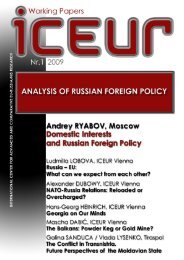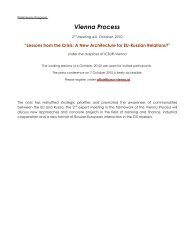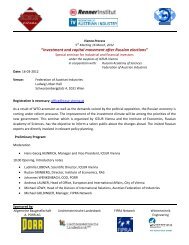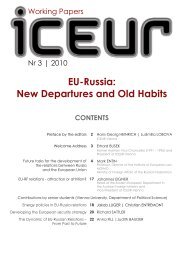Address - International Center for Advanced and Comparative EU ...
Address - International Center for Advanced and Comparative EU ...
Address - International Center for Advanced and Comparative EU ...
Create successful ePaper yourself
Turn your PDF publications into a flip-book with our unique Google optimized e-Paper software.
Alex<strong>and</strong>er DYNKIN<br />
Global Turmoil: Challenges <strong>for</strong> Russia<br />
Brazil, South Africa). On the one h<strong>and</strong>, there are many similarities with countries which are highly<br />
dependent on export of a limited number of commodities. In the Russian case, these are energy, basic<br />
chemicals, timber <strong>and</strong> metals (see Table 1).<br />
Energy<br />
Crude oil<br />
Export as a percentage of basic production<br />
(estimates <strong>for</strong> 2005-2007)<br />
54-58<br />
Petroleum products 46-48<br />
Natural gas 28-32<br />
Mineral coal 49-53<br />
Fertilizers<br />
Chemical fertilizers 75-85<br />
Timber<br />
Wood pulp 80-84<br />
Newsprint paper 60-65<br />
Plywood 59-63<br />
Untreated timber 55-60<br />
Metals<br />
Rolled iron (averaged) 45-48<br />
Nickel 90-95<br />
Cobalt 90-95<br />
Primary aluminium 80-85<br />
Titanium 70-75<br />
Zink 45-55<br />
Copper 30-40<br />
Table 1<br />
Thus the impact of the crisis in Russia is also similar to many emerging <strong>and</strong> even developing economies:<br />
- slowdown of production activity,<br />
- domestic credit crunch,<br />
- capital outflow,<br />
- depreciation of the national currency <strong>and</strong> increased inflation.<br />
On the other h<strong>and</strong>, by a number of factors Russia strays from the world anti-crisis trend, apart from the logic<br />
of anti-crisis measures of G –8 <strong>and</strong> the majority of G-20 countries. The comparison of crisis management<br />
measures in the USA, China <strong>and</strong> Russia, demonstrates these differences in the logic <strong>and</strong> practice of anticrisis<br />
policy (see Schedule 4).<br />
One can see that Russian anti-crisis policy was oriented rather toward the stabilization (if not conservation)<br />
of the existing ineffective structure of economics, than to using anti-crisis regulation <strong>for</strong> the rationalization<br />
<strong>and</strong> modernization of that structure, aiming at creating a new technological <strong>and</strong> economic basis <strong>for</strong> the<br />
improvement of the starting position in a post crisis global economy.<br />
Such a policy produced a number of serious problems. First <strong>and</strong> <strong>for</strong>emost, there is the problem of the Central<br />
Bank discount rate. In Russia it is still two-digit, even though it was lowered a bit. Meanwhile, in world<br />
economies an obvious trend dominates, decreasing the rate to split-fraction percentage points (in the US,<br />
IC<strong>EU</strong>R-Vienna Working Papers 2|2009 9









